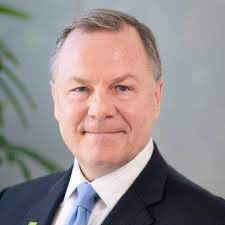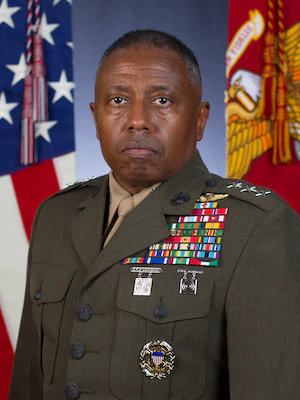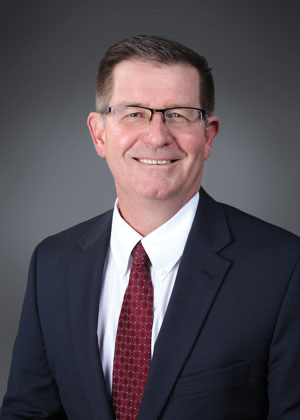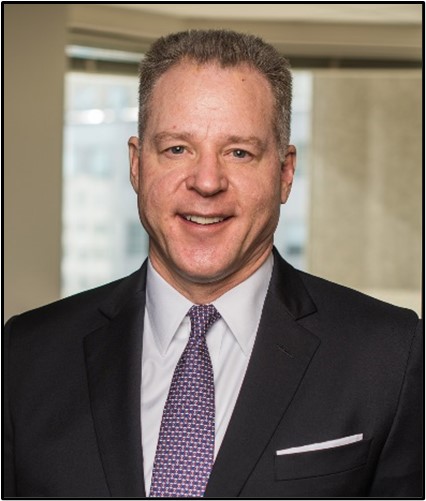Speaker 1 – Thursday, February 15th, 2024 at 11:15 a.m. in MSC Gates Ballroom
Mr. Larry Smith currently serves as Chairman of the Board for Tokyo Electron America, Inc. (TEA) and Tokyo Electron US Holdings (TEH), wholly owned subsidiaries of Tokyo Electron Limited (TEL) based in Tokyo, Japan with regional revenues over $2 billion annually and over 2000 employees. He joined the company in June 2000 and has more than 34 years of management experience in the semiconductor industry. Mr. Smith also served in the US. Army as an Armor Officer for five years. Larry has a BS in Engineering from the United States Military Academy, West Point. He also serves his community as Chairman of the Board for Mobile Loaves and Fishes.
Speaker 2 – Thursday, February 15th, 2024 at 4:00 p.m. in MSC Gates Ballroom
Lieutenant General Dimitri Henry assumed duties as Director for Intelligence, Joint Staff (J2), June 1, 2022. Lt. Gen. Henry enlisted in the Marine Corps in 1981 and attained the rank of Staff Sgt. After completion of the Broadened Opportunity for Officer Selection Training (BOOST) he was selected for the Marine Enlisted Commissioning Education Program (MECEP) and graduated from Texas A&M University in 1988, and was commissioned a 2nd Lt. from May 1990-May 1993, 2nd Lt. Henry served at 2nd Radio Battalion and deployed with 8th Marines (DESERT SHIELD/DESERT STORM), 26th MEU SOC (PROVIDE PROMISE), and was OIC of the II MEF Communications Center. In June 1993, 1st Lt. Henry attended Naval Postgraduate School, graduating with a Master of Science degree in Systems Engineering. In 1995, Capt. Henry was subsequently assigned to the Navy Information Warfare Activity at the National Security Agency. In December 1997, he reported to 15th MEU SOC serving as S2A and then S2. After two MEU SOC deployments Maj. Henry reported to Marine Corps Command and Staff College in August 2000.
From 2001-2004, Maj. Henry served as the Commanding Officer, Co H, Marine Cryptologic Support Battalion, San Antonio, TX. After command, Maj. Henry reported to I MEF G2 where he participated in Operation IRAQI FREEDOM as the Deputy G2 and Intelligence Planner from August 2004 – August 2006.
From August 2006-September 2008, Lt. Col. Henry commanded 1st Radio Battalion and executed two deployments to Iraq in support of Operation IRAQI FREEDOM. After command, he reported to the Naval War College (NWC) Newport, RI. After NWC he was assigned to Intelligence Department, HQMC, promoted to Colonel and took command of Marine Corps Intelligence Activity (MCIA) Quantico, VA in 2010. From 2012-2015, Col. Henry served at United States Central Command, Tampa, FL, as the J2 Operations Division Chief. From 2015-2016, Col Henry served as the Executive Officer to the Director of the Defense Intelligence Agency (DIA). From 2016-2017, Col. Henry served as the Chief of Staff, Intelligence Department, HQMC. Remaining at HQMC and upon promotion to Brig. Gen. on 20 July 2017, he served as the Director of Intelligence, United States Marine Corps until 2019.
Brig. Gen. Henry assumed the role of the Director of Intelligence at United States Central Command, Tampa, FL, on 1 March 2019 and was promoted to the rank of Major General on 9 July 2021. Lt. Gen. Henry was promoted to his current rank on 19 May 2022.
Lt. Gen. Henry’s personal decorations include the Defense Superior Service Medal, Legion of Merit, Bronze Star, Defense Meritorious Service Medal, Meritorious Service Medal, Navy Commendation Medal, Navy Achievement Medal, and the Combat Action Ribbon.
Speaker 3 – Friday, February 16th, 2024 at 11:15 a.m. in MSC Gates Ballroom
As the Labs Director for Sandia National Laboratories, Dr. James S. Peery provides leadership and management direction for the safe, secure execution of all Sandia missions. Before his appointment as Sandia Director on Jan. 1, 2020, James served as associate laboratory director for national security sciences at Oak Ridge National Laboratory (ORNL), overseeing research and development programs that support the national security missions of the U.S. Department of Energy and other government agencies. These included preventing and countering the spread of weapons of mass destruction, accelerating adoption of computing beyond Moore’s Law, providing resilience to cyber systems, and advancing autonomous national security capabilities through materials science, advanced manufacturing and electrification.
James served as Sandia’s Vice President for Defense Systems and Assessments from March 2015 to April 2017. In this role, he was responsible for developing and integrating advanced science and technology into state-of-the art systems for the National Nuclear Security Administration, the Department of Defense, and other national security agencies. Areas of focus included nuclear weapons electronics, integrated military systems, information operations, proliferation assessments, remote sensing and verification, space missions, surveillance and reconnaissance, and science and technology products.
From April 2010 to March 2015, James was Director of Sandia’s Information Systems Analysis Center, responsible for development and application of new information technologies that enable information superiority for customers of Sandia’s national security and critical infrastructure work. Prior to that, he directed the Computation, Computers, Information and Mathematics (CCIM) center, which forms the foundation of Sandia’s research and development activities in high performance computing. CCIM contains the Computer Science Research Institute, the joint Institute for Advanced Architectures and Algorithms with ORNL, and the Alliance for Computing at Extreme Scales with Los Alamos National Laboratory (LANL). During this period, James directed the NNSA’s Advanced Simulation and Computing Program (ASC). James served in several leadership roles at LANL from 2002 to 2007 before returning to Sandia in the positions of Hydrodynamic Experiments Division Leader, Principal Deputy Associate Director of LANL’s Nuclear Weapons program and Program Director of the NNSA’s ASC.
James began his career at Sandia in 1990. He worked in the Computational Solid Mechanics and Structural Dynamics Department and the Computational Physics Department. James has been responsible for the development of state-of-the-art, massively parallel computational tools spanning the fields of high energy density physics to structural dynamics. James’ major research areas are in Arbitrary Lagrangian-Eulerian algorithms and parallel algorithms, where he has published more than 50 papers. As part of the Salinas team, James was awarded the 2002 Gordon Bell Award. James holds a doctorate in nuclear engineering from Texas A&M University.
Speaker 4 – Saturday, February 17th at Final Banquet for SCONA 69 participants
A native of Indianapolis, Indiana, he graduated in 1986 from the University of Notre Dame with Bachelor of Arts degrees in History and Business Administration and received his commission through the NROTC program. In 1988, he was designated a Naval Flight Officer (NFO), flying the carrier-based E-2C Hawkeye command and control aircraft.
In 1998 he graduated from the Naval Postgraduate School’s two-year strategic studies curriculum with distinction and received the Superintendent’s Thesis Award. In 2013 he received his doctorate in security studies from the Naval Postgraduate School (NPS). He was the first selectee to the Navy Staff’s N3/N5’s new doctoral program at NPS and the first Ph.D. student in NPS’s National Security Affairs Department. For his dissertation research he received the 2009–10 Naval History and Heritage Command’s Samuel Eliot Morison Naval History Scholarship.
While still on active duty his dissertation was published in 2015 by the U.S. Naval Institute Press. His highly regarded Toward a New Maritime Strategy: American Naval Thinking in the Post-Cold War Era was selected in 2017 by CNO Admiral John Richardson and again in 2021 by CNO Admiral Michael Gilday for the CNO’s Recommended Reading List.
Operationally, he did two tours in VAW-116 Sun Kings flying the E-2C Hawkeye, including combat operations in support of Operation Desert Storm (1991) on USS Ranger (CV 61) and Operation Southern Watch (1999) on USS Constellation (CV 64), respectively. He commanded VAW-112 Golden Hawks (2005–06), including combat operations in support of Operation Iraqi Freedom while flying off USS Carl Vinson (CVN 70) for which the squadron was awarded the CNO’s Airborne Early Warning Excellence Award. Overall, he logged 2,900 flight hours, 500 carrier landings, and 88 combat flights.
Ashore, he served as a flight instructor at VAW-110 at NAS Miramar, CA (1992–94); flag aide, commander of U.S. Naval Forces Central Command/U.S. Fifth Fleet in Bahrain (1994–96); Russia and Ukraine desk officer, Joint Staff J5 (2001–03); branch chief, OPNAV N513 Strategy and Concepts (2006); and branch chief, OPNAV N511 Advanced Concepts (2010–11), where he was the lead Navy writer for the Joint Operational Access Concept. He served a year in Djibouti as the director of Strategy and Plans (J5), Combined Joint Task Force – Horn of Africa (2012). His last tour was in Tampa, FL as the deputy director for Strategy, J5 Strategy, Plans, and Policy at U.S. Special Operations Command (2013–16).
Awards include: Defense Superior Service Medal (2); Legion of Merit; Defense Meritorious Service Medal; Meritorious Service Medal (2); Air Medal (4; one with Combat V); Joint Commendation Medal; and Navy/Marine Corps Commendation Medal (3; one with Combat V).
After retiring from the Navy in 2016, he served a Senior Fellow for three years at the Center for Strategic and Budgetary Assessments (CSBA), a think tank in Washington DC. In 2019 joined the Naval History and Heritage Command on the Washington DC Navy Yard as the Deputy Director of the Commander’s Action Group. In November 2022 he joined Army Futures Command at its headquarters in downtown Austin, TX.
Recent publications include a chapter titled “What Navy Strategists and Defense Planners Should Think About in the Era of Maritime Great Power Competition” in The U.S. Navy: Case Studies in Its Past, Present, and Future, ed. Thomas-Durell Young (2021); a chapter titled “Elmo Zumwalt’s Project Sixty: Driving Institutional Change in an Era of Great Power Competition at Sea” in Conceptualizing Maritime and Naval Strategy: Festschrift for Captain Peter M. Swartz, U.S. Navy (Ret.), ed. Sebastian Bruns and Sarandis “Randy” Papadopoulos (2020); and a CSBA study, The U.S. Navy and the Future of Sea Control: The Competition for Global Access in an Era of Maritime Great Power Rivalry with China (2018).




